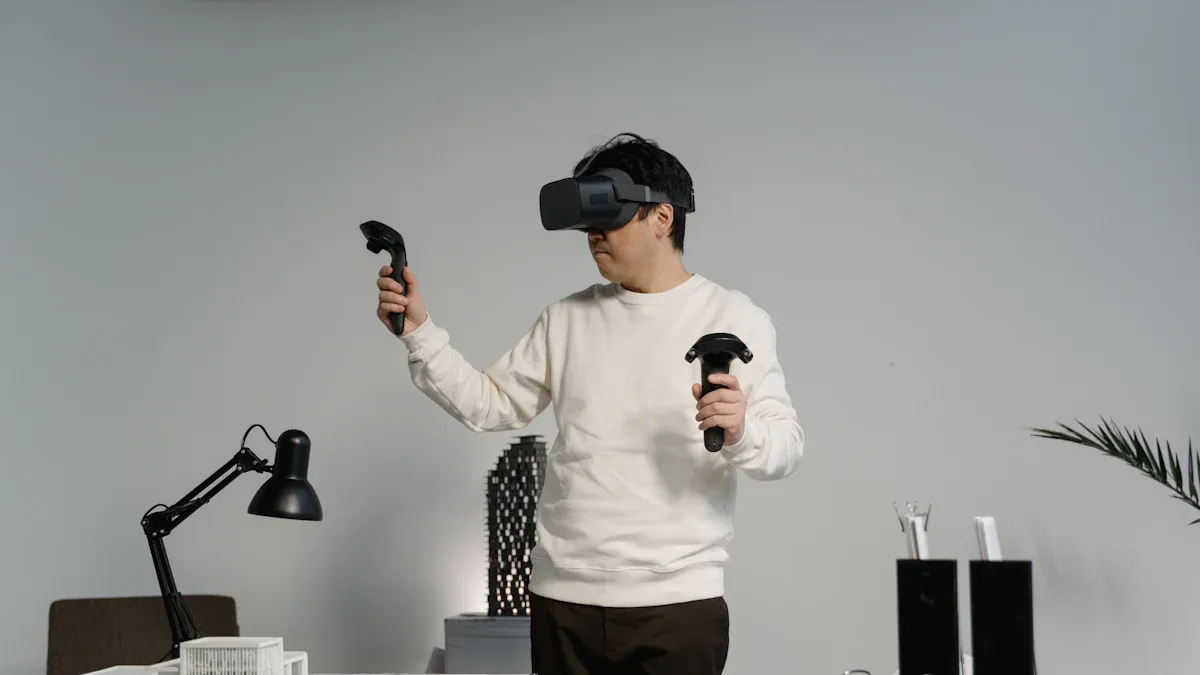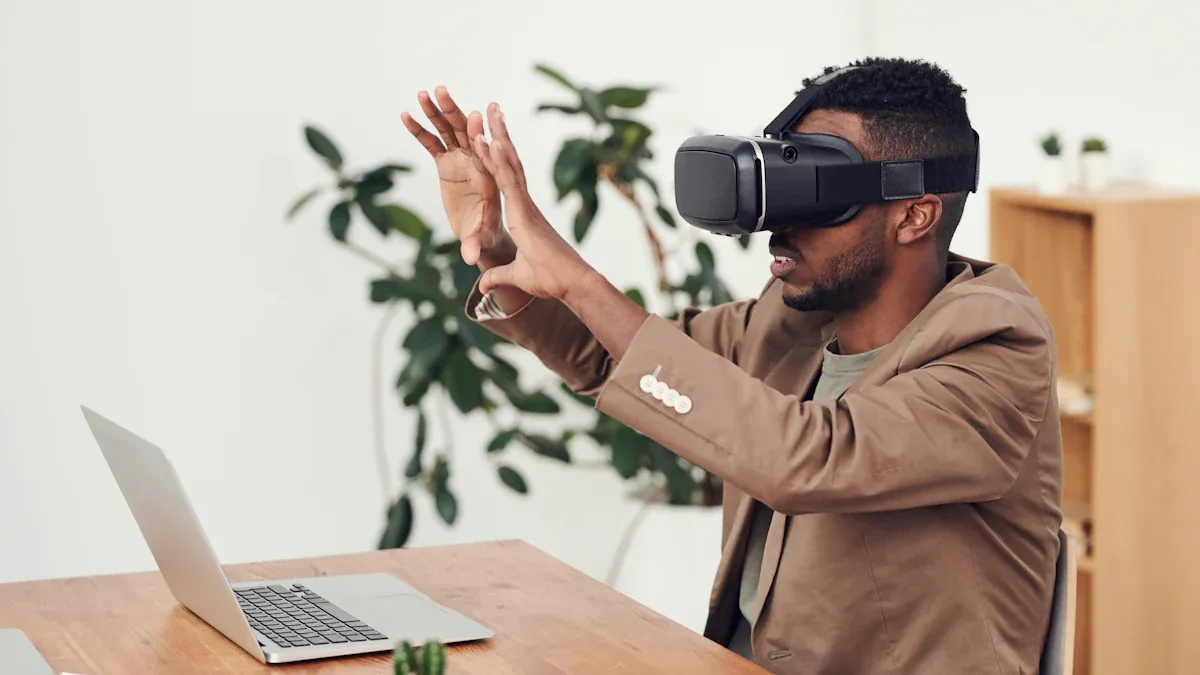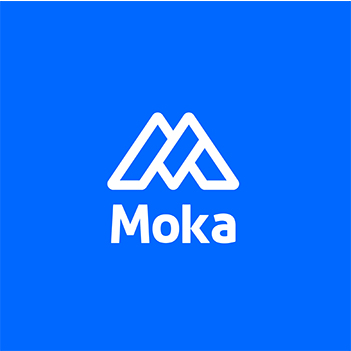How Virtual Reality is Changing the Way Employees Learn

Virtual Reality in Employee Training: Hype or Reality? Virtual reality is changing how workers learn by making training exciting. People remember 75% of what they learn with VR, but only 5% from lectures. Workers using VR do 69% better than those using old ways. VR also cuts training time by 40% and boosts performance by 70%. These advantages make VR a big deal for companies wanting better training. With realistic practice, VR connects learning to real-life tasks. It helps workers build skills safely in a controlled space.
Key Takeaways
Virtual reality (VR) training helps employees remember more. They recall 75% of what they learn, compared to only 5% from lectures.
VR training improves work skills. Workers do 69% better and finish training 40% faster than with older methods.
VR makes learning fun and interactive. It keeps employees focused and reduces wasted time.
VR gives safe and realistic practice spaces. Employees can learn skills without real-world dangers, especially in healthcare and factories.
Using VR training saves money over time. It cuts costs for travel, materials, and old training methods.
Traditional Employee Training: Problems and Challenges
Common Training Methods
Classroom-based learning
Classroom learning has been used for many years. It includes lectures, group talks, and tests. While it allows face-to-face interaction, it often uses passive learning. Employees listen to lessons but don’t actively participate. This makes it hard to remember what they learn. Many struggle to use classroom knowledge in real-life situations.
Online training modules
Online training is flexible and easy to access. Workers can use it anywhere, which is great for remote jobs. But many online programs are not interactive. They mostly have videos and quizzes that don’t hold attention. Studies show interactive online learning helps people remember 25-60% of material. Classroom methods only help 10-15%. This shows the need for better digital tools.
Why Traditional Methods Don’t Work Well
Lack of engagement and interactivity
Old training methods often don’t keep workers interested. Passive setups like lectures or plain online courses don’t involve them. Research says 73% of learning is wasted because workers aren’t engaged. Without interaction, workers don’t get feedback and feel unsure about their progress.
Limited real-world application
Many training programs teach theory, not practice. Workers find it hard to use what they learn in real life. For example, strict classroom setups don’t fit everyone’s learning style. This makes it harder to remember lessons. Below is a table showing common problems:
Problem | Explanation |
|---|---|
Low Engagement | Passive learning leads to poor memory and no real-time feedback. |
Rigid Learning Styles | Traditional methods don’t fit different ways people learn. |
Hard to Apply Knowledge | There’s a gap between learning and using it in real life. |
Ignoring Emotional Needs | Stress and anxiety are often overlooked, making learning harder. |
One-Time Training | Training happens once and doesn’t support ongoing learning. |
High costs and logistical issues
Old training methods cost a lot of money and time. In 2023, U.S. companies spent over $100 billion on training, but results were poor. Classroom training needs spaces, printed materials, and travel costs. Online training is cheaper but needs big investments to create. Outdated lessons make it hard for workers to stay competitive in fast-changing jobs.
Gallup says low worker engagement costs the world $8.8 trillion each year. This shows how bad training hurts businesses. Companies need better ways to keep workers engaged and get better results.
Virtual Reality in Employee Training: Hype or Reality?

The Unique Benefits of VR
Immersive and realistic simulations
Virtual reality gives hands-on learning that feels real. It lets you practice tasks in a safe, fake world. For example, surgeons using VR work 29% faster. They also make six times fewer mistakes than others. This type of training builds confidence and sharpens skills. You can learn without the dangers of real-life practice.
Experiential learning and skill retention
Learning by doing helps you remember better. VR training keeps you active, so you remember more. Studies show VR helps people remember 75% of what they learn. Old methods only help 10-20%. Whether it’s using machines or talking to customers, VR helps you learn and use skills well.
Cost-effectiveness and scalability
VR costs a lot at first but saves money later. It removes the need for travel, materials, or repeated classes. VR can train many workers at once, no matter where they are. By 2027, the VR training market will grow to $6.3 billion. This shows more companies are using it.
How VR Enhances Training Effectiveness
Real-time feedback and performance tracking
VR gives instant feedback to help you improve quickly. It tracks your progress and shows where you need to get better. Companies like VR because it feels real and gives useful tips. It can improve worker performance by up to 70%.
On-demand, repetitive learning for proficiency
Practicing often is key to getting good at something. VR lets you redo lessons as much as you need. Unlike old ways, VR doesn’t cost extra for more practice. This makes learning faster and easier. It cuts training time by 40%, helping both workers and companies.
Real-World Uses of Virtual Reality in Training
Virtual reality is changing how workers learn in many fields. It gives hands-on practice that feels real. Let’s see how it helps in different areas.
Healthcare and Medical Fields
Practicing surgeries and emergencies
VR lets you practice surgeries and handle emergencies safely. For example, VR surgery training makes fewer mistakes and better results. Florida uses VR to train responders for kids’ emergencies. Trainees face tough situations to prepare for real-life crises. Studies show VR helps surgeons work 83% faster and 70% better.
Learning empathy and patient care
VR also teaches soft skills like kindness and talking to patients. It shows how to handle tough talks and care for people. This training helps you do better in real-life patient care.
Manufacturing and Industrial Sectors
Learning to use and fix machines
In factories, VR helps you learn to use and fix machines. You can practice without breaking anything or getting hurt. VR helps you remember 80% of what you learn, compared to 20% with old methods. This makes learning faster and safer.
Staying safe in risky places
VR shows you how to stay safe in dangerous jobs. You can practice safety rules without real danger. This training helps you handle emergencies and follow safety rules. It also reduces accidents and improves work quality.
Retail and Customer Service
Getting better at talking to customers
In stores, VR helps you practice talking to customers. It teaches you how to solve problems and answer questions. Walmart used VR, and customer happiness went up by 10%.
Learning about products and selling
VR helps you learn about products in a fun way. You can explore items virtually and explain them better to customers. Studies show VR improves memory, which helps you sell more.
Corporate and Leadership Development
Conflict resolution and team-building
Virtual reality (VR) is changing how workers solve problems and build teams. It puts you in real-like situations to practice solving conflicts. For example, VR can show a tense team meeting. You can try different ways to calm things down. This hands-on practice boosts your confidence and helps you work better with others.
Managers using VR for bias training have learned a lot. VR shows what bias looks and feels like in real life. One manager said, “Wow, that’s what it really feels like.” This makes the lesson stick 3.75 times better than classroom learning. VR is great for teaching people skills.
Here’s how VR helps leaders grow:
Metric | VR Training Performance |
|---|---|
Emotional connection to content | |
Confidence to apply skills | 275% more confident after training |
Speed of training | 4x faster than classroom training |
Focus during training | 4x better than online learning |
Cost-effectiveness | Saves more money than online learning |
Public speaking and presentation practice
Speaking in front of people can be scary, but VR helps. VR public speaking training (VRPST) puts you in places like meeting rooms or big halls. You can practice giving speeches and get feedback on your voice, movements, and speed. This helps you feel less nervous and speak better.
Studies show VRPST improves speaking skills a lot. Out of 14 studies, 13 showed good results. VR feels real and brings out true emotions, which helps you learn better. Practicing in a safe virtual space builds your confidence for real-life talks.
VR is a great tool for learning leadership and speaking skills. Whether solving problems or giving speeches, VR helps you practice safely and improve.
Challenges of Using Virtual Reality in Training
Cost and Investment Issues
Expenses for hardware and software
Using VR for training costs a lot at first. Companies need good VR headsets, strong computers, and special programs. These tools make training feel real but are expensive. Keeping them updated also adds to the cost. Still, once set up, VR saves money by cutting travel, paper, and space needs.
Making custom VR content
Creating VR lessons that fit your company is hard. Ready-made programs might not match your goals. Making custom content needs experts, which costs more. But custom VR lessons give workers better training, making it worth the price later.
Cost Factor | Description |
|---|---|
Initial Investment | |
Long-term Savings | VR training lowers costs over time. |
Travel Costs | No need for expensive travel for training. |
Facility Overhead | Less need for physical training spaces. |
Productivity Loss | Reduces downtime from old training methods. |
Ongoing Costs | Cuts spending on outdated training tools. |
Technical and Setup Needs
Special equipment and systems
VR training needs advanced tools like good headsets and computers. Companies also need IT teams to fix and update these tools. Without the right setup, training won’t work well.
Working with current systems
Adding VR to your current training setup can be tricky. You might need custom fixes to make everything work together. This takes time and effort, making it hard for some companies.
VR tools need regular updates and care.
Advanced tools are required for smooth training.
Making VR work with old systems can be tough.
Employee Adjustment and Learning
Getting used to new technology
Some workers may not like using VR. They might find it confusing or hard to use. Explaining how VR helps and showing them how it works can make it easier.
Giving enough help and practice
Workers need training to learn how to use VR. Companies should guide them to make the switch smoother. For example, Walmart’s VR training helped workers remember more and avoid accidents. But a study showed 59% of workers felt VR was too hard to use. Solving these problems is key to success.
Study/Source | Key Findings | Challenges |
|---|---|---|
University of Maryland | 29% better memory with VR training | 59% felt VR was too hard to use. |
PwC | 40% faster learning; 75% more engagement | 43% of companies struggle with adoption. |
Walmart | 10% better memory rates | No clear plan for using VR. |
Virtual reality is changing how workers learn by fixing old training problems. It makes learning fun and easier to remember. Research shows VR helps people keep knowledge longer and enjoy training more. For example:
People using VR remembered more after two weeks than with old methods.
Workers trained with VR did 69% better and learned four times faster.
VR also saves time and boosts work results. It cuts training time by up to 60% and improves worker performance by 70%. The VR training market may grow to $20.3 billion by 2027, showing its big role in workplace learning.
FAQ
What is virtual reality training?
Virtual reality training uses VR to create fake worlds for learning. You can safely practice skills in a space that feels real. This method makes learning more fun and easier to remember than old ways.
How does VR improve learning outcomes?
VR puts you in real-like situations, making learning active and fun. It gives quick feedback and lets you practice often. Studies show VR helps people remember 75% of what they learn and cuts training time by 40%.
Is VR training expensive?
Starting with VR can cost a lot for tools and lessons. But it saves money later by cutting travel, paper, and space costs. Many companies find it cheaper over time.
Can VR training work for all industries?
Yes! VR works in healthcare, factories, stores, and offices. It’s great for practicing tasks, learning safety, or building skills like talking and leading.
What if employees struggle with VR technology?
You can give clear steps and help workers get used to VR. Start with easy lessons to build their confidence. Most workers enjoy VR once they know how it works.
💡 Tip: Show a demo to make learning easier and reduce worries.
From recruiting candidates to onboarding new team members, MokaHR gives your company everything you need to be great at hiring.
Subscribe for more information

